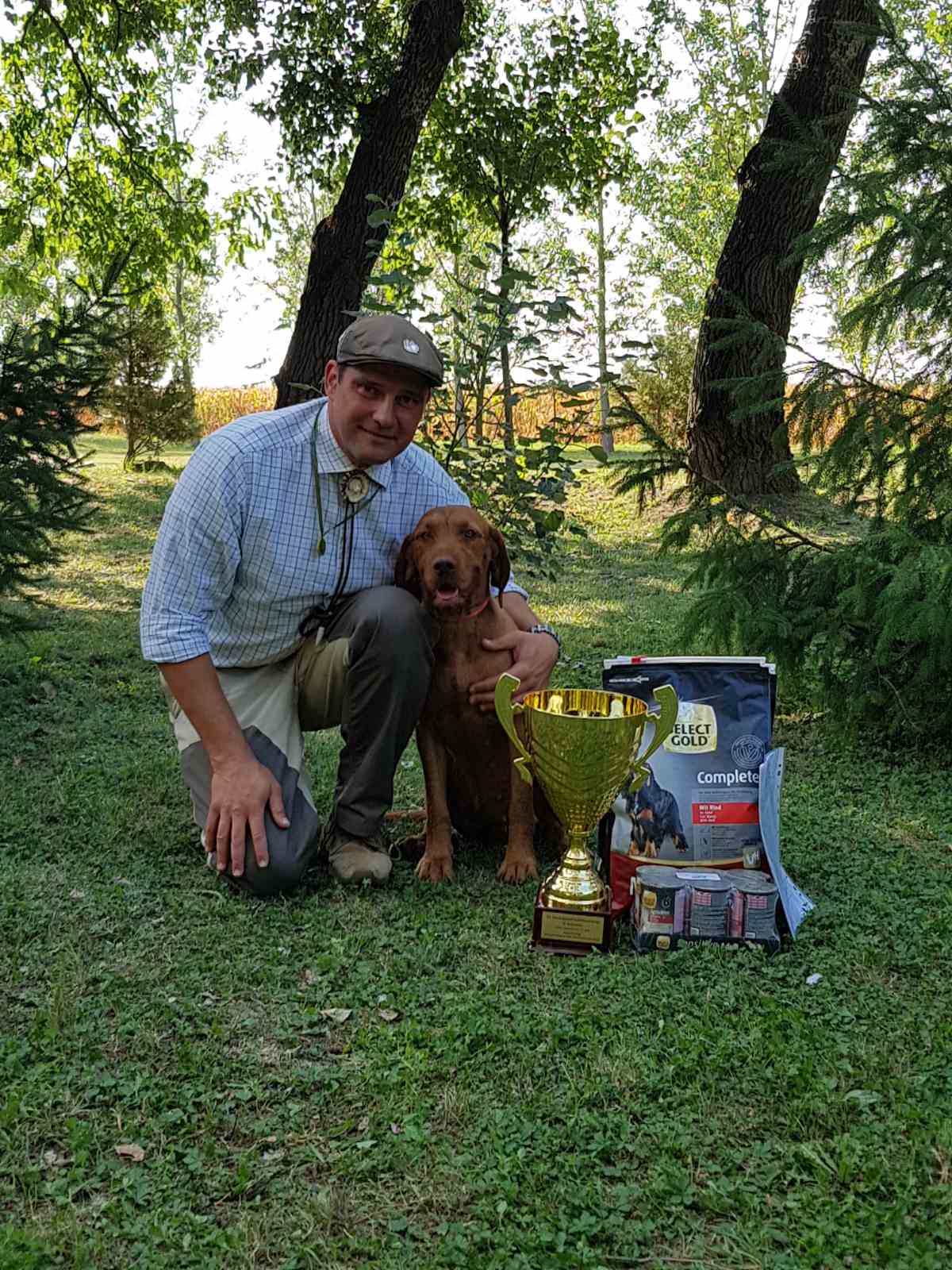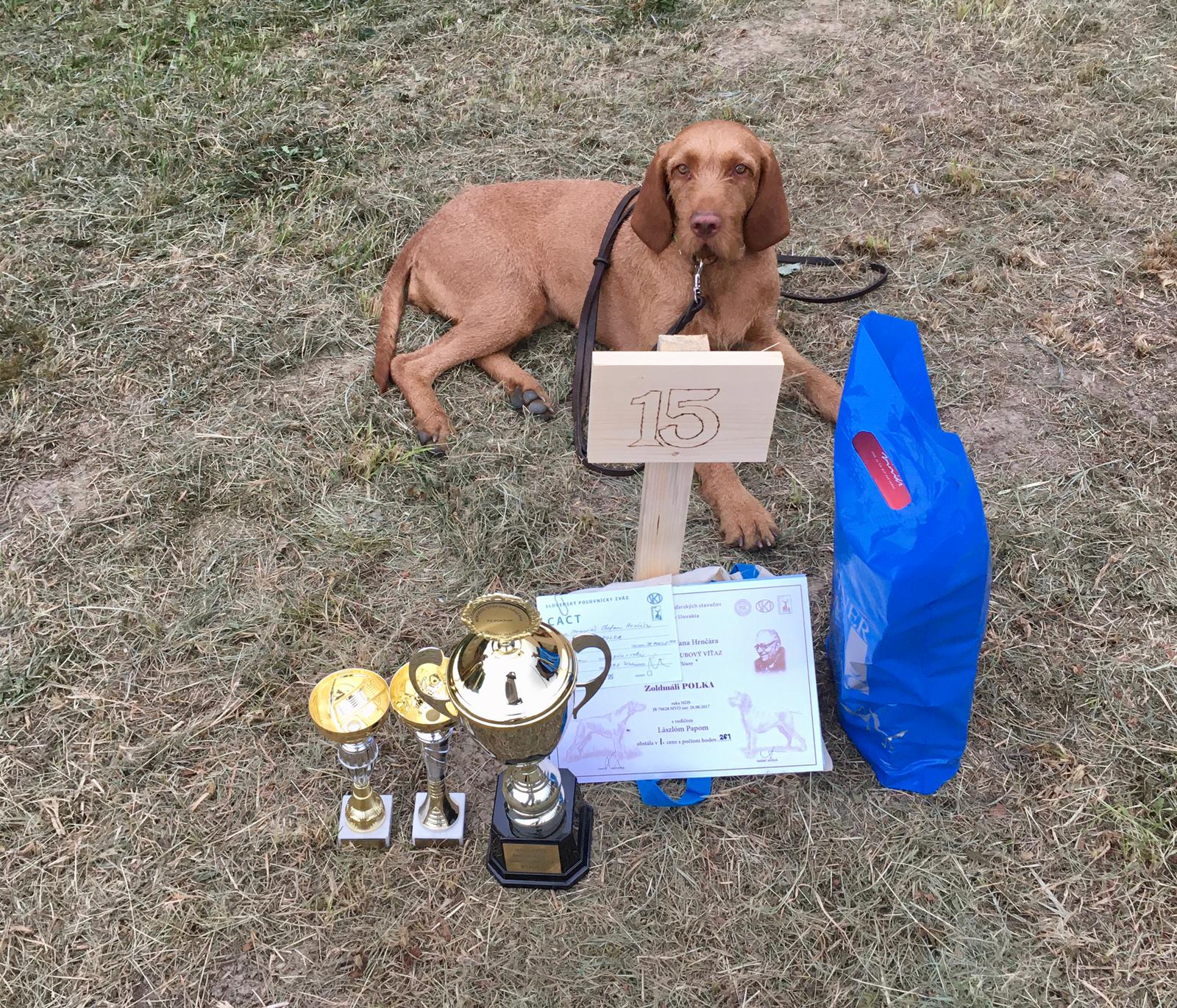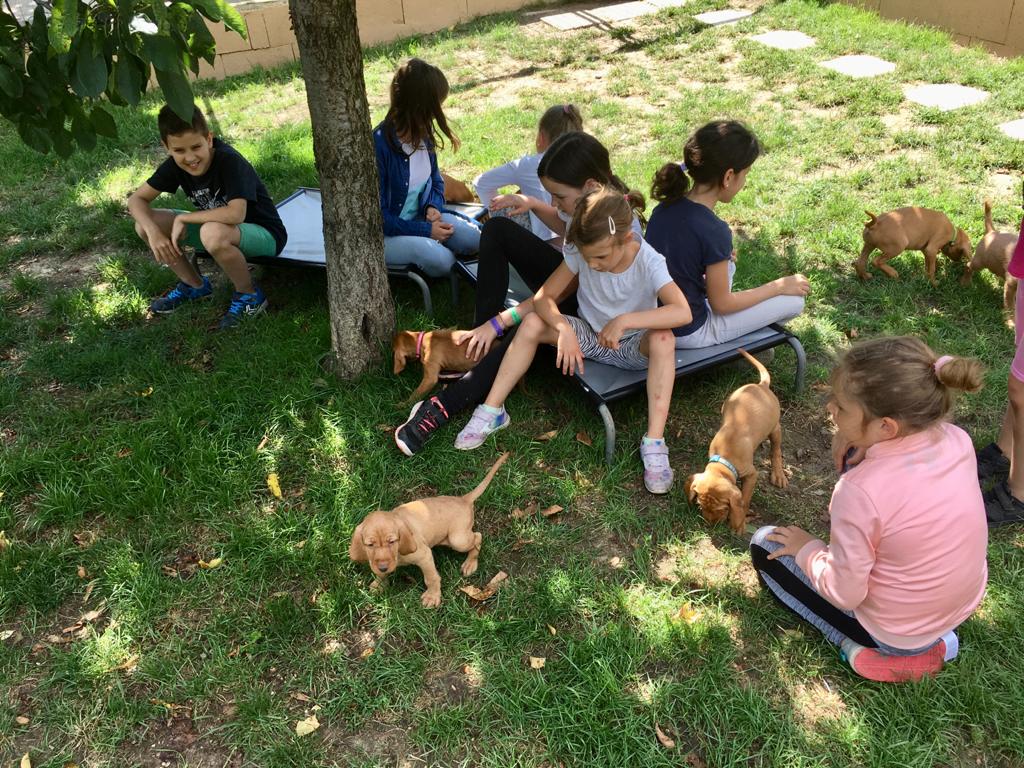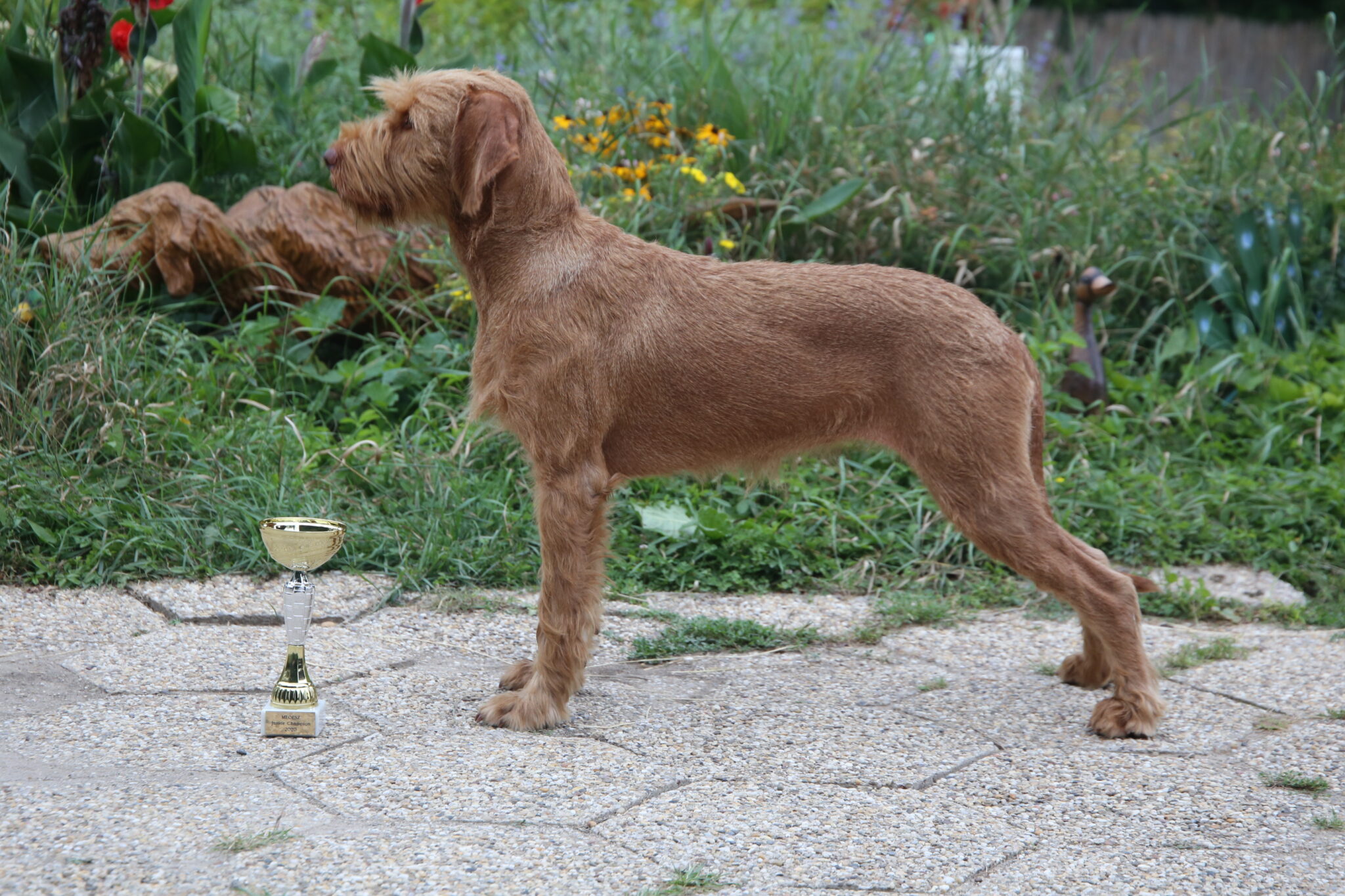[vc_row row_type=”row” text_align=”left” css_animation=””][vc_column][vc_column_text]I felt I needed this experience in my life, to test my dogs under the NAVHDA system, and also to encourage American breeders to do more work with their dogs. To my knowledge, there are only two Wirehwired Vizsla in the US as of now, who passed the NAVHDA Utility, both are Zoldmalis (Abel and Szinva, both done it in 1st prize). So I decided to enter Zoldmali Extreme (3 years old) and Délceg (2 years old) for the NAVHDA Utility Test and Zoldmali Kolibri for the Natural Ability test in Wisconsin, to show, its even possible to do it coming from Europe. Délceg and Kolibri are already owned by Eric Wallendal and Megan Nimmo Wallendal, Pivot Kennel, but since I was training them till that point, I didn’t feel it would be a problem to handle them on a test in May. When you enter to NAVHDA, you get a rule book, where you can read all the expectations of the tests. This info you can also find only at www.navhda.org . Unlinke in the European rule books, NAVHDA doesn’t specify how things are exactly judged, and what is taking your scored down. They hold so called Handler’s Clinics, where they explain these for future to be judges, and everyone interested. But Handlers Clinics are organized in specific times and locations, so being less than a week in the US, I never had the chance to attend one. I believe that not having specific rules for judging, it gives a greater freedom for the judges to evaluate and interpret a situation, which is often not advantageous, at least more difficult to prepare for. Also the fact that you only find out your overall scores in the very end of the test (not knowing what you did right or wrong and not getting any explanation for it) doesn’t give the handler a chance to improve on that test. Besides the Handler Clinic, most local NAVHDA Chapter members practice every weekend on the same area, where the tests are done. This is a very big advantage. They practice the same exercises over and over, what you perform on the test. Unfortunately we didn’t have a chance for that. Even though I handled two dogs on the NAVHDA Utility, I made the same mistakes with them, because I was only told the very end of the testing day, that a simple hand wave without any words on a duck search or a water retrieve is considered a command, and every command takes your score down with 1 note out of 4. So when your vizsla, who is knows from its high co-operation checks back on you from the corner of his eyes 50 meters ahead out in the water, which way I want him to search, and I wave my hands twice, I am down to a score 2, in 3rd prize. Likely he would have continued without any hand wave, but I didn’t know, its so highly penalized. As I was the only handled with my own two dogs doing the Utility, I didn’t even have the chance to look, how the others were doing. Quite tough conditions for a first timer. Not to mention the extraordinary humid and hot weather with 36C. This was topped with Extreme’s tail injury (limber tail or dead tail syndrome), that happened 2 days before the test and he was in such pain, it was questionable, he could run on the test. The vet gave him some anti-inflammatory and pain killer, but forgot to inform me about the side effect, that it would knock out the dog. So after Extreme was zonked out on his bed all day on Saturday, I had to make the decision to stop giving him the pain killer, and see what happens on Sunday in the test. He was not his usual self, but was quite ok compared to his state from two days before.
And something that I just recently realized is the huge differences the USA, midland Europe (FCI) and England, Scandinavia has in terms of what we expect from a pointing dog to do on the field. What one country expects, is a disqualifying fault for the other. And the US find their system so obvious, that again they don’t specify it in their rule book, yet if its done the other way, they might even disqualify a dog. So in the US, they expect a pointing dog to get in a solid point as soon as the dog smells the bird.
The dog should not move, but the handler walks ahead of the dog, and tries to flush the bird by kicking the grass. It often seems very odd from outside to watch, especially when you have a runner that you try to flush. Dog may only relocate the bird on command. On the test, only pen raised planted birds are used, but I would really like to see this type of work being efficient on wild birds, who run like hell. Up until now, I was not given a proper explanation, why this method is desired, but more Americans agreed, they would not hunt their dog on wild bird like this. The American system highly penalizes a dog, who would stalk up to the bird (yet nor flushing it), or flushing on owner’s command. In FCI, actually its the other way round, and you are not allowed to go ahead of your dog, but the two of you have to flush the bird together, or the dog on command. If the dog is not ‘creeping’ up to the bird but holds the point to firm, its penalized. If the dog is not keeping contact with a runner bird, its highly penalized. In England and in Scandinavia, the dog is expected to flush the bird on command, meaning after pointing, when the flush command is given, the dog makes a quick move towards the bird to flush it, and stays steady afterwards. In Finland, in the very high level they even expect the dog to come back to the owner from a point and lead the owner back to the bird. All these methods are trainable, but once you trained one, its very difficult to train another one for the same dog, especially if you only have a day or two for it. So that was our first big challenge on the test: having two dogs trained and tested under the FCI system and now doing everything the other way round with them.
So we had 2 Extreme and Délceg tested on that day on Utility, and 3 dogs were tested on NA (Natural Ability), a GSP and Zoldmali Kolibri (handled by me) and Z. Titok, (handled by Tarah Stratchan). First the Utility dogs started, early morning at about 7:30 am, trying to avoid the big head. Dogs had to work 30 minutes on the field, with handler (with gun), two guns and 3 judges. Chukars were planted prior to the run. Both Extreme and Délceg impressed the judges, both found and pointed 4 birds, birds were shot and retrieved. They both got 4s (max score) for everything in the field (including the retrieves and the tracking), only Extreme got a 3 for pointing, as out of the 4 birds he pointed, one was a runner and he started creeping towards the running bird (just like her was taught before) and the judges didn’t like that.
On the water they both got max scores for the healing exercise and the steadiness by blind, but we were unlucky with the duck retrieve. I was supposed to stay behind the duck blind with a gun, dog sitting steady next to me and a distraction gunner on the side. Duck was thrown after 4 shots from the opposite side of the lake which was about 70 meters away at least. There were duck decoys on the water that the dog had to ignore. Everything went well for Extreme, but when he came out and sat in front of me with the duck, when I wanted to take the dog, he just released 1 second sooner, and I didn’t get a proper grip and duck fell out of my hands. I got a 3 for that. It was my mistake.
Délceg unfortunately didn’t watch properly where the duck was thrown -(as it was pretty far) and as he was swimming out for the ‘forward’ command, he looked back for reassurance (as he didn’t yet see the duck) and I waved my hand ahead, he continued and brought the dog. Only in the end did I find it, it cost 1 score down. But all these I found out in the very end.
Live duck search was the very last exercise. It is the big fear of everyone. I was quite confident about my dogs’ abilities. In this exercise, they choose a big bond with marshy areas and they place a live duck out to the opposite side with a kayak.
You are supposed to send the dog for search with a command, and for max score, the dog has to search for 10 minutes and no further command can be given and even the slightest hand wave is considered a command. It doesn’t matter if dog doesn’t find the duck, it just has to spend the 10 minutes out. Now all these I know by now from experience, but its not written black and white in the NAVHDA rule book. In Europe, the live duck search means something totally different, there they release a winged duck thrown on the water from your side, and they wait till duck disappears, and dog has to follow its track on the water and retrieve it, or chase it to open water until its shot.
With NAVHDA, even though they call it a live duck search, the focus is not on the duck, but on the search, that the dog searches by itself for 10 minutes in the water. Here, dogs who try to keep in touch with owners and ask for feedback are not appreciated. We practiced this with both Extreme and Délceg for 3 days before the test on other water surfaces and they were really really good. As I said, I was very confident about my dogs. We got the chance to go and practice on the test ground on the previous Friday, and that was the plan, but because Extreme had the tail injury on that day and we spent the rest of the day at the vet, we couldn’t make the 4 hours drive. I was still confident about their performance, but as they are not machines, they can have their off days, and on their first go (when it mattered) none of them swam across to the other side with one go, but started exploring the closer areas and finished sooner than 10 minutes so a command was needed. Extreme was still not his usual self, because of his tail injury, and even freaked out from a water snake. Délceg did much better, he searched through two islands on both sides, only was given one hand wave, and I expected him getting a 3 or 4 (after Extreme got a 2), but surprisingly he got a 2 as well. Not really sure why. Judges said I gave two commands, but I don’t remember a 2nd. Once test was over and they were sent back individually for a 2nd round, they both swam across, searched for over 15 minutes and found the ducks. Really annoying to know, they would have done it easily, if we had the chance to practice at once! But overall I was super proud of them and I believe they made a very good impression on the judges and on the spectators. We got lots of compliments, a very good day for the breed.
Kolibri and Basil (Z. Titok) accomplished the Natural Ability test with max scores. Basil only started training 4 days before the test on the Zöldmáli Training Days I ran in Wisconsin. Her and her owner never had any former hunting training. Its quite a big thing, she passed the NA with max score! For me NAVHDA has some rules, that I just can’t understand. In the NA’s water part, a dummy is thrown in the water twice and for a full score, the has to swim in twice, but doesn’t have to retrieve, and no gun fired during this part of the test, so dogs are not tested for gushiness in the water, which is a way more difficult (sensitive) situation than taking a gunshot on the field!!! If your dog only goes in the water if a bird is thrown, you get low scores!!! For me, it would just go the other way round (and so it does in Hungary). If a dog retrieves a bird from the water (with a shot, proving the dog is not afraid of the gunshot while swimming) it gets full scores. But a dog, who just swims but doesn’t retrieve game, would fail!
To my knowledge, up until now, only 2 Wirehaired Vizslas passed the Utility in the USA, both were Zoldmalis (Abel and Szinva, both in 1st prize). So now there are another 2! 🙂
I hope many more will come! This breed needs more dedicated working homes!
It was a great experience, and if there ever would be a next time, I will be more prepared by than![/vc_column_text][/vc_column][/vc_row][vc_row row_type=”row” text_align=”left” css_animation=””][vc_column][vc_gallery type=”image_grid” images=”7488,7489,7490,7491,7492,7493,7494,7495,7496,7497,7498,7499,7487″ column_number=”5″ title=”The tests in pictures”][/vc_column][/vc_row]




